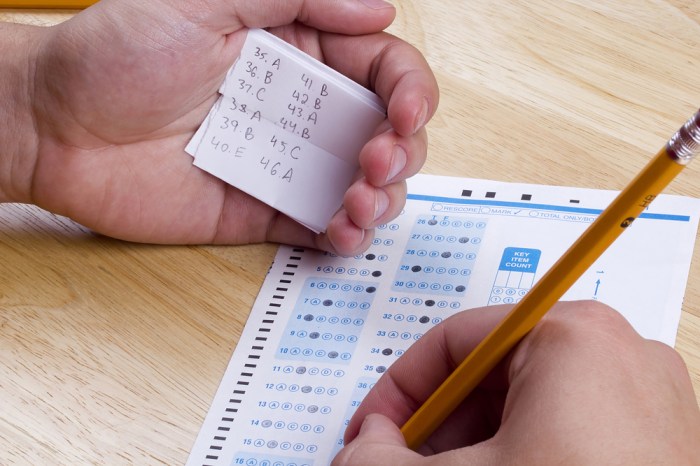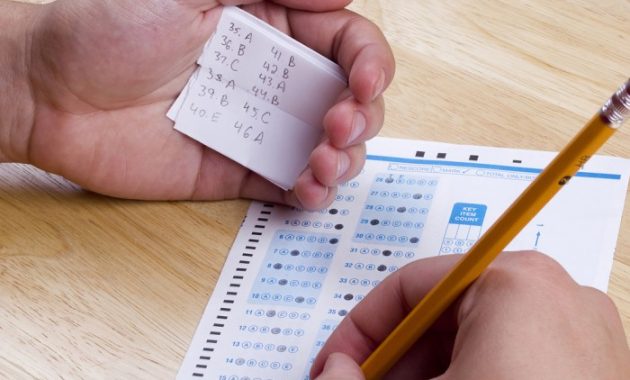Detecting Cheating on a Drawing Test
Cheating on a test drawing easy – So, you’re a proctor, tasked with the unenviable job of making sure your students aren’t pulling a Michelangelo during a drawing exam. It’s a delicate dance; you want to maintain a fair environment, but you also don’t want to be the art world’s version of the overly-suspicious airport security guard. Let’s talk about how to spot those sneaky artistic cheats.
Detecting cheating in a visual art context isn’t as simple as catching a kid peeking at a crib sheet. It requires a keen eye, a little bit of psychology, and maybe a dash of detective work. The subtle clues are often more revealing than blatant acts of plagiarism.
Common Signs of Cheating on Drawing Tests
Suspiciously similar drawings, especially among students seated near each other, are a major red flag. Imagine a classroom where five students all suddenly develop a remarkable talent for rendering hyper-realistic squirrels, despite having shown little prior skill. That’s a situation that calls for a closer look. Another sign is a sudden, inexplicable leap in skill level – a student whose work has been consistently mediocre suddenly produces a masterpiece.
It’s like watching a caterpillar transform into a butterfly in the span of a single exam period; something’s fishy. Finally, keep an eye on students who are excessively secretive about their work, constantly shielding their drawings or acting nervously. They might be hiding something.
Strategies for Proctors to Detect Cheating, Cheating on a test drawing easy
Proctors need to be observant, like seasoned art critics scrutinizing a controversial piece. Strategic seating arrangements can help minimize opportunities for copying. Avoid clustering students who are known to be friends or who have a history of academic dishonesty. Regular patrolling of the room, without being overly intrusive, is crucial. The simple act of walking around can deter cheating and allow for discreet observation of student behavior.
Furthermore, proctors should carefully examine the drawings themselves, looking for inconsistencies in style or technique. A sudden change in shading style or line quality within a single drawing could indicate that the student received outside help.
Let’s be clear: cheating on a test, while seemingly easy, is a shortcut to nowhere. It undermines your own learning and growth. Instead of taking that deceptive path, channel your energy into something genuinely rewarding, like mastering a challenging skill. Think about the intricate details of a bass shark drawing easy tutorial; it demands focus, precision, and practice—qualities that will serve you far better in the long run than any illicit advantage on an exam.
Ultimately, true success comes from honest effort, not shortcuts.
Inconsistencies in a Student’s Work as Indicators of Cheating
Inconsistencies can be as blatant as a sudden shift from shaky, uncertain lines to perfectly smooth curves, or as subtle as a change in the way perspective is handled. For example, if a student consistently struggles with proportions throughout their portfolio, but suddenly masters them in the exam, it raises questions. A significant difference in style or technique between the exam drawing and previous assignments also warrants scrutiny.
Imagine a student whose usual style is loose and impressionistic suddenly producing a highly detailed, photorealistic drawing during the exam – that’s a significant inconsistency worth investigating.
Checklist for Proctors During a Drawing Test
A checklist can help ensure that proctors are thorough and consistent in their observation. This is not about accusing students, but rather about maintaining a fair and equitable testing environment.
| Item | Check |
|---|---|
| Strategic seating arrangement | |
| Regular room patrols | |
| Observation of student behavior (nervousness, secrecy) | |
| Comparison of exam work with previous assignments | |
| Analysis of drawing for inconsistencies in style or technique | |
| Documentation of suspicious activity |
Visual Representation of Cheating Methods

Alright, so we’ve talked about catching cheaters, but let’s get into the nitty-gritty – the visual evidence itself. Think of it as a detective’s guide to spotting a drawing-test fraudster. We’re talking about the telltale signs, the subtle clues that scream “I cheated!” louder than a screaming goat.
Hidden Notes
Imagine this: a seemingly innocent-looking eraser. But upon closer inspection, you notice tiny, almost microscopic writings etched onto its side. The student expertly used a very fine-tipped pencil to scribble down key formulas or vocabulary words, practically invisible to the naked eye unless you’re really scrutinizing it. The technique involves using a super sharp pencil and careful shading to hide the writing within the texture of the eraser.
The final product? An eraser that looks normal, but holds a secret trove of cheat notes. The visual cue? An unusually worn-down eraser, especially concentrated on one side, might arouse suspicion, prompting a closer examination.
Strategic Placement of Materials
This method is all about clever positioning. Think of a student strategically placing their water bottle or a seemingly random textbook at a precise angle, using the reflection in the shiny surface to discreetly glance at hidden answers. The “tools” are everyday items, subtly manipulated to become cheating aids. The technique requires precise placement and a keen understanding of light reflection.
The final product is an innocent-looking arrangement of school supplies, but the reflective surface is carefully positioned to provide a mirror image of a cheat sheet. The visual cue? A student constantly glancing towards a seemingly unrelated object, particularly a reflective surface, or an unusual arrangement of belongings on their desk.
Modified Drawings
This one’s a bit more sophisticated. The student might start with a genuinely attempted drawing, but subtly incorporates elements copied from another source. Imagine a student drawing a landscape, but a suspiciously perfect rendering of a specific tree or building stands out amongst the rest of the less detailed work. The “tools” are a source image – maybe a photograph or a downloaded image – and skillful blending techniques.
The technique involves integrating copied elements into their own work, making it appear as if they’re part of the original composition. The final product is a drawing that’s partially original, partially copied, creating a visually jarring mismatch in style and detail. The visual cue? A sudden spike in detail or accuracy in a specific part of the drawing, contrasting with the overall quality of the work, particularly if that element is a near-perfect replica of something easily found online or in a textbook.
Impact on the Learning Environment

Cheating on a drawing test, like sneaking a peek at your neighbor’s masterpiece during a timed exam, isn’t just about getting a better grade; it’s a seismic event that shakes the very foundations of the classroom. It’s like dropping a durian into a room full of perfectly ripe mangoes – the stench lingers, the damage is done, and nobody’s really happy about it.The ripple effect of cheating isn’t confined to the cheater’s own conscience (or lack thereof).
It’s a contagion that spreads through the entire learning environment, poisoning the well of trust and fair play. Imagine a class where the effort of diligent students is undermined by the shortcuts taken by others. It’s a demoralizing situation, leading to a classroom climate where genuine learning takes a backseat to the desperate pursuit of inflated grades.
Effect on Honest Students
Witnessing cheating firsthand can be incredibly damaging to honest students. It breeds resentment, fosters a sense of unfairness, and can lead to disillusionment with the entire educational process. These students might question the value of hard work and honest effort if they see others reaping rewards without putting in the same level of commitment. It’s like watching a marathon runner get handed the gold medal while you’re still struggling to finish the first mile – you start to wonder if it’s even worth the effort.
This can lead to decreased motivation, a decline in academic performance, and even a cynical attitude towards education. They might even start to rationalize cheating themselves, thinking, “If everyone else is doing it, why shouldn’t I?” It’s a slippery slope, my friends, a slippery slope.
Comparison of Classrooms
A classroom where academic integrity is upheld is a vibrant ecosystem of collaborative learning and mutual respect. Students are encouraged to help each other, not to undermine each other. There’s a shared understanding that honest effort is valued above all else. The atmosphere is one of mutual trust and support, where students feel comfortable asking for help and celebrating each other’s successes.
It’s like a garden where every plant gets the sunlight and water it needs to thrive. In contrast, a classroom rife with cheating is a toxic wasteland. Trust is eroded, collaboration is hampered, and the focus shifts from learning to deception. It’s a breeding ground for resentment, anxiety, and a general sense of unfairness. It’s like a jungle where only the strongest (or the sneakiest) survive.
The overall learning experience suffers immensely, creating an environment where genuine intellectual growth is stifled.
User Queries: Cheating On A Test Drawing Easy
What are the long-term consequences of cheating beyond failing a test?
Long-term consequences can include damage to your reputation, difficulty gaining acceptance into future programs, and a lack of genuine skill development, hindering your future career prospects.
How can I report cheating I witness?
Report your concerns to a teacher, professor, or designated authority figure within your institution. Many schools have specific reporting mechanisms in place.
Are there any legal repercussions for cheating?
Depending on the severity and institutional policies, legal repercussions may apply, especially in professional or high-stakes testing situations.
What if I’m struggling and tempted to cheat?
Seek help! Talk to your teachers, professors, or academic advisors. Utilize tutoring services, study groups, and other support systems available to you. Remember, there are resources to help you succeed honestly.

